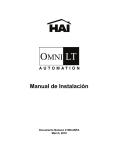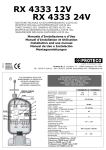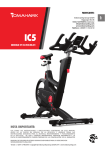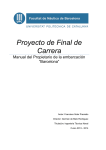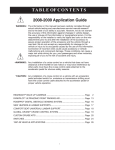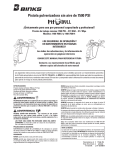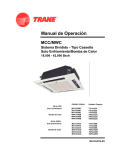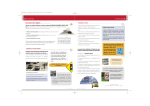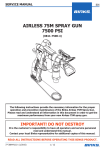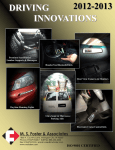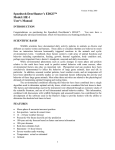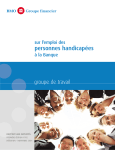Download Installation instructions concerning seat heating elements
Transcript
Installation instructions concerning seat heating elements for the front seats Instruction de montage pour chauffage de sièges avant Instrucciones de instalación de la calefacción para asientos delanteros FORM #15000024A, REV RTP, 12-04-06 © W.E.T. Special Products GmbH, Odelzhausen GB Index Seite 1. General advice about safety . . . . . . . . . . . . . . . . . . . . . . . . . . . . . . . . . . . . . . . . . . . . . . . . . . . . . . . . . . . . . . . 2 2. Components list . . . . . . . . . . . . . . . . . . . . . . . . . . . . . . . . . . . . . . . . . . . . . . . . . . . . . . . . . . . . . . . . . . . . . . . . 5 3. Installation. . . . . . . . . . . . . . . . . . . . . . . . . . . . . . . . . . . . . . . . . . . . . . . . . . . . . . . . . . . . . . . . . . . . . . . . . . . . . 6 4. Wiring diagram . . . . . . . . . . . . . . . . . . . . . . . . . . . . . . . . . . . . . . . . . . . . . . . . . . . . . . . . . . . . . . . . . . . . . . . . 13 5. Operating instructions . . . . . . . . . . . . . . . . . . . . . . . . . . . . . . . . . . . . . . . . . . . . . . . . . . . . . . . . . . . . . . . . . . 15 A a = min. 250 mm a = min. 9 1/32” 1. General safety advice The installation of a ‘Seat Kit’ set is shown in figures 1 to 21. A ’Single Element Kit’ set can either by installed in the seat according to figures 1 to 7 and figures 14 to 21, or inthe backrest according to figure 1 and figures 8 to 21. - a a B It is impossible to install the Carbotex® retro-fitted seat heating kits whenever: • the seat covers are adhered to the seat’s foam padding, or • the seat’s longitudinal channels are spaced less than 250 mm apart (fig. A). - The battery terminals should be disconnected in advance, before working on the vehicle’s electrical circuits. The security codes (radio, navigation system, etc.) should be noted. - The seat cover and seams should remain unmodified for seats with side air-bags. The heating elements are only allowed to be fitted in the middle of the seat. Please refer to the manufacturer’s vehicle manual. - Please follow the manufacturer’s vehicle manual for seats with seat belt or a seat occupancy-recognition device, or both. - The seat heating elements are only allowed to be installed by qualified and trained personnel who are knowledgeable about electronic systems and upholstery. Improper installation can adversely affect the system’s reliability and risk overheating. - Use original kit components only. - The heating elements must be secured and mounted free of folds and creases. Heating elements are not allowed to be damaged during the installation. Avoid exposure to any sharp object that could compromise the integrety of the heating element. It is imparative for durability and the system’s reliability that the complete heating element is positioned correctly. Any modifications to the seat’s components, which affect the heating elements or come into contact with them, can influence the durability and reliability. - The heating element is only allowed to be operated at +12 V ±3 V. It should ideally be connected to the onboard power supply via the ignition voltage and the protective fuse should ideally be put in an empty bay in the fuse box. The seat heating unit should be protected by a fuse with a maximum rating of 12 amps. - The heating elements are only allowed to be modified as described in these installation instructions, except width which is not allowed to altered in any way. - The wire harness is not allowed to be modified. Ensure that the wire harness is secured and fastened properly. The wire harness must be routed properly so the seat can move freely without any difficulty. Contact with sharp edges, bending or pulling of wire must be avoided, in order to prevent the wire harness from being damaged. The onboard main supply and the wire harness cross-section must be adapted to the extra current loads if necessary. Refer to the vehicle’s wiring diagram for additional information. - The foam padding must be clean and free from separating agents, grease, silicone, dust and oil before the heating mats are secured to it. The full adhesive strength will only be attained if sufficient pressure is applied during the installation and when an adequate period is allowed for the chemical reaction to take place (48 hours approx.). A heating element is not allowed to be detached and reinstalled after it has been installed completely for the first time. - The heating elements are not allowed to come into contact any of the seat’s electrical conductive components – such as padding clips or the seat’s frame – at all: danger of short-circuiting! - The heating performance on the cover’s surface varies according to the type of seat or cover. Every millimetre of the cover’s thickness prolongs the heating time by up to 15 seconds. - The seat heating unit’s function must be explained to the customer and the operating instructions must be provided. The customer must be informed about all safety aspects. The operating instructions must describe how the fuse is positioned. - The points in the operating instructions must also be followed for the installation. - The heating output on the cover’s surface varies according to the type of seat cover. Every millimetre of the cover’s thickness prolongs the heating time by up to 15 seconds. - The seat heating unit’s function must be explained to the customer and the operating instructions must be provided to them. The customer must be informed about the safety aspects. The operating instructions must describe how the fuse is positioned. - The points in the operating instructions must also be followed for installation. Warning: Seat heaters must not be installed in vehicles that will be used by paraplegic or other occupants that cannot sense heat, and customers have to notify the installer if the vehicle is sold to a third party. FORM #15000024A, REV RTP, 12-04-06 © W.E.T. Special Products GmbH, Odelzhausen 2 FR Sommaire Seite 1. Consignes de sécurité générales . . . . . . . . . . . . . . . . . . . . . . . . . . . . . . . . . . . . . . . . . . . . . . . . . . . . . . . . . . . 3 2. Jeu de pièces . . . . . . . . . . . . . . . . . . . . . . . . . . . . . . . . . . . . . . . . . . . . . . . . . . . . . . . . . . . . . . . . . . . . . . . . . . 5 3. Montage . . . . . . . . . . . . . . . . . . . . . . . . . . . . . . . . . . . . . . . . . . . . . . . . . . . . . . . . . . . . . . . . . . . . . . . . . . . . . . 6 4. Schéma. . . . . . . . . . . . . . . . . . . . . . . . . . . . . . . . . . . . . . . . . . . . . . . . . . . . . . . . . . . . . . . . . . . . . . . . . . . . . . 13 5. Notice d’utilisation . . . . . . . . . . . . . . . . . . . . . . . . . . . . . . . . . . . . . . . . . . . . . . . . . . . . . . . . . . . . . . . . . . . . . 17 A a = min. 250 mm a = min. 9 1/32” 1. Consignes de sécurité générales Le montage d’un kit « Seat Kit » est représenté aux illustrations 1 à 21. Un kit « Single Element Kit » peut être monté soit dans le siège selon les illustrations 1 à 7 et 14 à 21 soit dans l’accoudoir selon les illustrations 1 et 8 à 21. - - a - a - - B - - - - - Le montage des chauffages de siège après-vente Carbotex® n’est pas possible si • les garnitures de siège sont collées sur la mousse de siège ou • le siège présente des rappels longitudinaux avec un intervalle de plus de 250 mm (photo A). Avant toute opération exécutée sur l’équipement électrique du véhicule, toujours débrancher la batterie. Noter absolument les codes de sécurité des mémoires volatiles (autoradio, système de navigation, etc.). Sur les sièges avec airbags latéraux, la garniture de siège et les coutures doivent rester inchangées. Les éléments de chauffage doivent être appliqués uniquement au centre du siège. Tenir compte également des consignes du constructeur automobile. Pour les sièges avec prétentioneur de ceinture et/ou détecteur d’occupation du siège, veuillez tenir compte des consignes du constructeur automobile. Le montage de chauffages de siège doit être exécuté uniquement par un personnel qualifié et formé possédant des connaissances de l’équipement électrique et du garnissage. Tout montage incorrect peut porter préjudice à la fiabilité du système et entraîner une surchauffe. Utiliser uniquement les composants originaux fournis pour éviter tout fonctionnement défectueux et toute mise en danger éventuelle de personnes. Les éléments de chauffage doivent être fixés solidement et sans plis. Ils ne doivent pas être endommagés lors du montage. Des causes fréquentes d’endommagement sont par ex. des agrafes nez de porc, des outils auxiliaires ou une structure de siège à arêtes vives. Le placement correct de l´élément de chauffage complet influence de manière décisive la durabilité et la fiabilité du système. Toute modification apportée aux composants de siège agissant sur les éléments de chauffage ou entrant en contact avec eux peut nuire à la durabilité et à la fiabilité. L’élément de chauffage doit fonctionner uniquement avec +12V ±3V. L’idéal est de raccorder l’alimentation par la tension d’allumage et d’effectuer la protection par fusible à un emplacement libre de la boîte à fusibles. Le chauffage de siège doit être protégé par un fusible d’une valeur maximum de 12A. Les éléments de chauffage doivent être modifiés uniquement comme décrit dans la présente instruction de montage. Une modification de la largeur n’est, par contre, pas autorisée (photo B). Le câblage ne doit pas être modifié. Veillez à une pose et à une fixation conformes des faisceaux. Ceux-ci doivent être fixés de telle manière que le siège puisse être déplacé sans problème sur toute la course de réglage. Pour éviter d’endommager l’isolation de fils, éviter tout contact avec des arêtes vives, tout pliage et toute contrainte de traction des câbles. Le réseau de bord et les sections de fils doivent éventuellement être adaptés aux charges électriques supplémentaires. En cas de doute, veuillez-vous aider du schéma du véhicule. Avant la fixation des nappes chauffantes, veiller à ce que la mousse soit propre et exempte d’agents de démoulage, de graisse, de silicone, de poussière et d’huile. On obtient une force d’adhésion maximum uniquement avec une pression d’appui suffisante lors du montage et en laissant agir la colle suffisamment longtemps (env. 48 heures). Une fois monté, un élément de chauffage ne doit plus être retiré ni remonté. Les éléments chauffants ne doivent en aucun cas entrer en contact avec des composants de siège conducteurs d’électricité tels que, p. ex., des agrafes nez de porc ou la structure de siège. Danger de courts-circuits ! Selon le type de siège ou de coiffe, il est possible d'obtenir des puissances de chauffe différentes à la surface du siège. Chaque millimètre d’épaisseur de garniture prolonge la durée d’échauffement de jusqu’à quinze secondes. Lors de la remise du véhicule, il convient d’expliquer le fonctionnement du chauffage de siège au client et de lui donner la notice d’utilisation. Le client doit en outre être informé des aspects de sécurité. L’emplacement du fusible doit être décrit dans la notice d’utilisation. Il convient également de respecter pour le montage les points mentionnés dans la notice d’utilisation. FORM #15000024A, REV RTP, 12-04-06 © W.E.T. Special Products GmbH, Odelzhausen 3 E Índice Seite 1. Instrucciones generales de seguridad . . . . . . . . . . . . . . . . . . . . . . . . . . . . . . . . . . . . . . . . . . . . . . . . . . . . . . . 4 2. Juego de piezas . . . . . . . . . . . . . . . . . . . . . . . . . . . . . . . . . . . . . . . . . . . . . . . . . . . . . . . . . . . . . . . . . . . . . . . . 5 3. Instalación. . . . . . . . . . . . . . . . . . . . . . . . . . . . . . . . . . . . . . . . . . . . . . . . . . . . . . . . . . . . . . . . . . . . . . . . . . . . . 6 4. Diagrama de circuitos. . . . . . . . . . . . . . . . . . . . . . . . . . . . . . . . . . . . . . . . . . . . . . . . . . . . . . . . . . . . . . . . . . . 13 5. Instrucciones de manejo. . . . . . . . . . . . . . . . . . . . . . . . . . . . . . . . . . . . . . . . . . . . . . . . . . . . . . . . . . . . . . . . . 19 A a = min. 250 mm a = min. 9 1/32” 1. Referencias generales de seguridad La instalación del "Seat Kit" se representa en las figuras 1 a 21. El "Single Element Kit" puede instalarse, bien en el asiento según las figuras 1 a 7 y 14 a 21, o en el respaldo según las figuras 1 y 8 a 21. - - a - a - - B - - - - - No es posible instalar la calefacción reequipable del asiento Carbotex®, cuando: • el forro de los asientos está adherido con espuma o • el asiento tiene hendiduras longitudinales con una distancia entre sí, menor de 250 mm (fig. A). Antes de trabajar en el sistema eléctrico del vehículo, debera de desconectar la batería. Deberían anotarse los códigos de seguridad para memorias volátiles (radio, sistema de navegación, etc.). En asientos con bolsas de aire laterales no deben modificarse el forro del asiento ni las suturas. Los elementos térmicos sólo deben instalarse en el centro del asiento. Tener también en cuenta las instrucciones del fabricante del automóvil dado. En asientos con mecanismo de tensado de cinturones o de reconocimiento de ocupación, tener en cuenta las instrucciones del fabricante del automóvil dado. La instalación de calefacciones de asientos sólo deberá realizarla personal calificado e instruido que tenga conocimientos de electricidad y sistemas de asientos. Una instalación inadecuada puede disminuir la confiabilidad del sistema y producir sobrecalentamiento. Solamente deben utilizarse los componentes originales suministrados. De no ser así, puede darse un mal funcionamiento e incluso existir peligro físico. Los elementos térmicos deben estar fijados seguros y lisos sobre la superficie. Los elementos térmicos no deben dañarse al instalarlos. Causas frecuentes de desperfectos son pinzas en la parte acojinada de la calefaccion de asiento, herramientas auxiliares y bastidores de asientos con cantos agudos. El correcto emplazamiento del elemento térmico completo es decisivo para la durabilidad y la confiabilidad del sistema. Cualquier cambio en los componentes del asiento que afecten a los elementos térmicos o entran en contacto con ellos pueden afectar la durabilidad y la confiabilidad del sistema. El elemento térmico sólo debe operarse a +12V ±3V. Lo ideal sería conectar la alimentación de corriente a través del encendido. El fusible debería disponer para ser ideal de un espacio libre en la caja de fusibles. La calefacción para asientos debería operarse como máx. con un fusible de 12 A. Los elementos térmicos sólo deben modificarse según se describa en estas instrucciones de instalación. Por el contrario, no se permite cambiar la anchura (fig. B). No debe cambiarse el cableado. Procurar tender y fijar los cables de forma correcta. Los cables deben tenerse de tal forma que pueda moverse el asiento sin problemas en todo el recorrido. Para evitar daños en el aislamiento de los cables, debe evitarse todo contacto con bordes afilados, torceduras y tensión de tracción. En su caso deben adaptarse a la corriente adicional la red de a bordo y la sección de los cables. En caso de duda, consultar el diagrama de circuitos del vehículo. El elemento de espuma debe estar limpio y carecer de desmoldeantes, grasas, silicon, polvo y aceite antes de fijar las esteras térmicas. La fuerza de adhesión completa se alcanza instalado y ejerciendo una presión adecuada, siendo el tiempo de actuación suficiente de aprox. 48 horas. Los elementos térmicos ya completamente instalados no deben volver a desprenderse, ni volver a instalarse. Los elementos térmicos no deben entrar en contacto con ningún componente conductor eléctrico del asiento, como pinzas del acolchado o el bastidor del asiento. Existe el peligro de cortocircuito. Según el modelo de asiento y de forro, existen diferentes potencias caloríficas en la superficie del forro. Cada milímetro de grosor del forro aumenta el calentamiento en hasta 15 segundos. Al entregar el vehículo al cliente, debe explicársele el funcionamiento de la calefacción del asiento y entregarse las instrucciones de servicio dadas. Además debe informarse al cliente de aspectos sobre la seguridad. La ubicación del fusible debe describirse en las instrucciones de servicio dadas. También deben tenerse en cuenta los puntos de las instrucciones de servicio para realizar la instalación. FORM #15000024A, REV RTP, 12-04-06 © W.E.T. Special Products GmbH, Odelzhausen 4 2. Components list/Jeu de pièces/Juego de piezas Single B A F E D 4x C G Dual + L 2x H F M E 4x FORM #15000024A, REV RTP, 12-04-06 © W.E.T. Special Products GmbH, Odelzhausen I G J K 5 3. 1 Installation/Montage/Instalación Single Dual + L Code 2 20 - 50 mm 4/5” - 2” 3 mm L 3 3 mm L 4 40 mm 1 5/8” 20 - 50 mm 4/5” - 2” L 40 mm 1 5/8” L FORM #15000024A, REV RTP, 12-04-06 © W.E.T. Special Products GmbH, Odelzhausen 6 3. Installation/Montage/Instalación 5 + 150 mm - 150 mm x L x L 6 L 7 E E E L L FORM #15000024A, REV RTP, 12-04-06 © W.E.T. Special Products GmbH, Odelzhausen 7 3. Installation/Montage/Instalación 8 9 L 3 mm L 3 mm L 20 - 50 mm 4/5” - 2” 11 10 40 mm 1 5/8” 20 - 50 mm 4/5” - 2” 40 mm 1 5/8” L L 12 + 150 mm - 150 mm x L x L L FORM #15000024A, REV RTP, 12-04-06 © W.E.T. Special Products GmbH, Odelzhausen 8 3. Installation/Montage/Instalación 13 L E E E L 14 20 mm 4/5” M FORM #15000024A, REV RTP, 12-04-06 © W.E.T. Special Products GmbH, Odelzhausen 9 3. Installation/Montage/Instalación 15 F Single C B Imax.= 2,6 A 16 K J Dual + I F H Imax.= 11,5 A FORM #15000024A, REV RTP, 12-04-06 © W.E.T. Special Products GmbH, Odelzhausen 10 3. Installation/Montage/Instalación 17 Single G 18 Dual + G FORM #15000024A, REV RTP, 12-04-06 © W.E.T. Special Products GmbH, Odelzhausen 11 3. Installation/Montage/Instalación 19 20 1. 1 21 GB/US FR E 2. 0 Complete the operating instructions and provide to the customer. Compléter la notice d’utilisation et la remettre au client. Rellenar las instrucciones de manejo y entregárselas al cliente. FORM #15000024A, REV RTP, 12-04-06 © W.E.T. Special Products GmbH, Odelzhausen 12 4. Wiring diagram/Schéma/Diagrama de circuitos Single A C 15 A + 15 B D + GND R3 Ub R2 6k8 22k R1 LED1 rot S1 FORM #15000024A, REV RTP, 12-04-06 © W.E.T. Special Products GmbH, Odelzhausen 13 4. Wiring diagram/Schéma/Diagrama de circuitos Dual + L 15 A M I + 15 H + GND R2 R3 Ub Rel1 R1 4k7 rot (2) (3) LED1 (1) grün FORM #15000024A, REV RTP, 12-04-06 © W.E.T. Special Products GmbH, Odelzhausen LED2 14 5. Operating instructions for seat heating units Safety advice - Warning The seat heating unit is only allowed to be operated when a person is sitting on it. This person must feel temperatures and be able to react to them. Persons who experience difficulty with feeling temperatures – such as all paraplegic persons, children and old people – are not allowed to use the seat heating unit because there is a risk that they will suffer injury from burns. The seat heating unit, like any other heating appliance, should not be switched on and left unsupervised. Unintentional activation of the seat heating unit should be avoided. - If the seat ocupant feels an excessive temperature after the seat heating unit has been switched on, change to lower settings to reduce heat or switch off completely. - The seat heating element is not allowed to come into contact with knives, nails, needles or tools, which could penetrate and pierce the seat’s surface or the heating elements. - The ‘high’ setting (Seat kit) is unsuitable for continuous operation. The seat heater element O will be or / off (to be checked off by installer). - - - O will not be deactivated when vehicle ignition is The position of the seat heater fuse is:____________________________________________________ (to be filled out by installer). The seat heating unit must be switched off after the engine has been switched off if the installation is powered via the continuous duty plus circuit, in order to avoid discharging the battery. Sharp objects are not allowed to be transported or put down on the seat. Excessive weights or heavy objects that are put down on the seat can cause damage to the seat heating unit and affect its operation adversely. It is therefore recommended not to put objects on the seat. If it is noticed that an unusual smell develops when the seat heating unit is switched on or if there is an uneven distribution of heat on the seat or backrest – or between the seat and backrest as the case may be – then the seat heating unit must be switched off immediately and the specialized workshop must be contacted. The seat heating unit is only allowed to be modified or decommissioned by a specialized workshop. The seat is not allowed to be covered with insulating materials (including blankets or rugs, jackets, cushions, bags, handbags, retro-fitted seat mats, children’s seats, seat reinforcement, protective covers, etc.) whenever the seat heating unit has been switched on. The seat heating unit’s function could be affected if it is operated when these materials are present: this could risk damage to the seat or burning injuries to seat occupant. The seat heating unit is not allowed to be exposed to excessive moisture. Small amounts of the following liquids do not adversely affect the seat heating unit from being operated safely and continuously after it has dried out: perspiration, beverages (e.g., coffee, cola, mineral water, etc.), brine (5 % in solution), cleaning agents containing ammonia (10 % by volume), cleaning agents containing alcohol (10 % by volume), cleaning agents for plastic or vinyl, as well as soapy water. Warning Excessive contact with the any liquids can adversity affect the performance of the seat heating unit and cause its service life to be reduced. The seat heating element must not be turned on at any time when exessive moisture has dampend the seat surface or internal components, or both. The seat heating element must not be operated, when articles of clothing is wet or moist. The seat heating element is unsuitable for drying clothing or objects. FORM #15000024A, REV RTP, 12-04-06 © W.E.T. Special Products GmbH, Odelzhausen 15 5. Operating instructions for seat heating units Operation The Single Element kit (On/Off control) The Seat Kit (High/Low/Off control) - - The seat heating unit is switched on by moving the switch upwards. The seat heating element is switched on by moving the switch upwards or downwards. - - ‘ON’ Switch to the ‘ON’. The LED will shine yellow. The heat will be noticeable within 3 to 4 minutes. The heating must be switched off in order to avoid overheating, whenever the temperature is too high. - ‘High’ Switch on the ‘High’ setting. The LED will turn red. The heat will be noticeable within 2 minutes. The heating time can vary according to the type of seat cover material and kind of clothing/coat that is being worn. The heating must be switched to the ‘Low’ setting in order to avoid overheating, when the desired temperature has been reached. ‘Low’ Switch on the ‘Low’ setting. The LED will turn green. The heating time can vary according to the type of cover and the kind of clothing that is being worn. Troubleshooting The heating does not function although it is switched on. Check the fuse and change it if necessary. Consult a The LED is not luminated. specialized workshop if the fuse is in order. The LED is not luminated although the heating is functioning and switched on. The LED in the switch is defective. The heating does not function although it is switched on. The temperature of the seat cover could be too high due The LED is on. to high interior temperature on the vehicle interior. The thermostat in the seat heating unit is connected. Wait until the seat cover’s temperature has fallen and try again. The distribution of heat in the seat or back is uneven. Switch off the seat heating unit and consult a specialized workshop. The fuse burns out repeatedly. Check the fuse rating. Consult a specialized workshop if the fuse rating is correct. FORM #15000024A, REV RTP, 12-04-06 © W.E.T. Special Products GmbH, Odelzhausen 16 6. Notice d’utilisation pour les chauffages de siège Consignes de sécurité - Avertissement : faire fonctionner le chauffage de siège uniquement si une personne se trouve sur le siège. Cette personne doit être capable de sentir les températures et de pouvoir y réagir. Les personnes qui, par expérience, ont des difficultés à sentir les températures, telles que les paraplégiques, les enfants et les personnes âgées, ne doivent pas utiliser le chauffage de siège, car il y a danger de brûlures. Le chauffage de siège, tout comme tout autre dispositif de chauffage, ne doit jamais être mis en marche et laissé sans surveillance. Il convient d’éviter tout actionnement involontaire du chauffage de siège. - Si la personne se trouvant sur le siège avec chauffage de siège allumé devait sentir des températures trop élevées, réduire la puissance de chauffage ou arrêter complètement le chauffage. - Le chauffage de siège ne doit pas entrer en contact avec des objets pointus tels que couteaux, clous, aiguilles ou outils qui pourraient pénétrer dans la surface du siège ou le chauffage et les transpercer. - Le niveau « High » (Seat Kit) ne convient pas pour le fonctionnement en continu. - Montage du fusible (à compléter par l’installateur). Alimentation en tension : - - - O 12V par plus permanent O 12V par allumage Position du fusible :____________________________________________________ Avec l’installation par plus permanent (12V, borne 30), le chauffage de siège doit être coupé avec moteur arrêté afin d’éviter le déchargement de la batterie. Il est interdit de transporter ou de déposer des objets pointus sur le siège. Des poids trop élevés ou le dépôt d’objets lourds sur le siège peuvent entraîner un endommagement du chauffage de siège et nuire à son fonctionnement. Il est donc fortement déconseillé de déposer de tels objets sur le siège. Si des odeurs inhabituelles devaient s’échapper du chauffage de siège allumé ou en cas de répartition très irrégulière de la chaleur sur le siège ou l’accoudoir et/ou entre le siège et l’accoudoir, arrêter immédiatement le chauffage de siège et contacter l’atelier spécialisé. Seul un atelier spécialisé doit également procéder à toute transformation et toute mise hors service du chauffage de siège. Après démontage, le chauffage n’est plus fonctionnel. Lorsque le chauffage de siège est allumé, le siège ne doit en aucun cas être recouvert de matériaux isolants (y compris couvertures, vestes, coussins, sachets, sacs, coussins de siège après-vente, sièges pour enfants, rehausseurs de siège, housses, etc.). Faire marcher le chauffage en combinaison avec ces matériaux pourrait influencer le fonctionnement et entraîner un endommagement du siège et/ ou des brûlures de personnes. Le chauffage de siège ne doit pas être exposé à une humidité excessive. Après séchage, les liquides suivants en petites quantités ne portent pas préjudice au fonctionnement sûr et durable du chauffage de siège : sueur, boissons (p. ex. café, coca-cola, eau minérale, etc.), eau salée (solution 5 %), nettoyants à base d’ammoniac (10% du volume), nettoyants contenant de l’alcool (10 % du volume), nettoyants plastique ou vinyle et eau savonneuse. Avertissement : tout contact excessif avec les liquides cités ci-dessus peut entraver le fonctionnement du chauffage de siège et raccourcir sa durée de vie. Le chauffage de siège ne doit jamais être allumé lorsque la surface et/ou les composants internes sont humides ou mouillés par une substance quelconque. Le chauffage de siège ne doit pas non plus être utilisé avec des vêtements mouillés ou humides. Le chauffage de siège n’est pas non plus conçu pour le séchage de vêtements ou d’objets. FORM #15000024A, REV RTP, 12-04-06 © W.E.T. Special Products GmbH, Odelzhausen 17 5. Notice d’utilisation pour les chauffages de siège Commande Single Element Kit (réglage 1 niveau) Seat Kit (réglage 2 niveaux) - Pour allumer le chauffage de siège, actionner l’interrupteur vers le haut. - Pour allumer le chauffage de siège, actionner l’interrupteur vers le haut ou vers le bas. - Niveau « Un » : Allumer sur niveau « Un ». La LED jaune s’allume. La chaleur est perceptible en l’espace de 3-4 minutes. Si la température devait être trop élevée, couper le chauffage pour éviter toute surchauffe. - Niveau « High » : Allumer sur niveau « High ». La LED rouge s’allume. La chaleur est perceptible en l’espace de 2 minutes. Selon la nature de la coiffe et du vêtement porté, le temps d’échauffement peut varier. Une fois la température souhaitée atteinte, le chauffage doit être commuté en niveau « Low » pour éviter toute surchauffe. - Niveau « Low » : Allumer sur niveau « Low ». La LED rouge s’allume. La chaleur est perceptible en l’espace de 5-6 minutes. Selon la nature de la coiffe et du vêtement porté, le temps d’échauffement peut varier. Si la température devait être trop élevée, couper le chauffage pour éviter toute surchauffe. Élimination des défauts Chauffage ne fonctionne pas bien qu’il soit allumé. La LED ne s’allume pas Vérifier le fusible et le remplacer le cas échéant. Si le fusible est OK, demander conseil à un atelier spécialisé. LED ne s’allume pas bien que le chauffage fonctionne et L’éclairage de l’interrupteur est défectueux. soit allumé. Chauffage ne fonctionne pas bien qu’il soit allumé. La LED s’allume. Si la température de la garniture atteint un seuil élevé, par ex. à cause des rayons du soleil, le thermostat dans le chauffage de siège s’ouvre et coupe le chauffage. Attendre que la température du siège redescende et réessayer. Répartition irrégulière de la température de chauffage dans le siège ou l’accoudoir. Éteindre le chauffage de siège et demander conseil à un atelier spécialisé. Défaillance répétée du fusible. Vérifier la valeur du fusible. Si la valeur est correcte, demander conseil à un atelier spécialisé. FORM #15000024A, REV RTP, 12-04-06 © W.E.T. Special Products GmbH, Odelzhausen 18 6. Instrucciones de servicio para calefacciones de asientos Instrucciones de seguridad - Aviso: La calefacción del asiento sólo debe utilizarse cuando haya una persona sentada. Esta persona debe poder sentir la temperatura y reaccionar al respecto. Las personas que tienen dificultad en sentir la temperatura, como los paralíticos, niños y personas mayores, no deben utilizar la calefacción del asiento por existir peligro de quemaduras. La calefacción para asientos, como cualquier otro dispositivo calefactor, no debería dejarse conectada sin vigilarse. Debe de procurarse no encender la calefacción para asientos de forma inadvertida. - Si la persona que se encuentra en el asiento, sintiese una temperatura excesiva con la calefacción encendida, debe reducirse la potencia o desconectar totalmente la calefacción del asiento. - La calefacción para asientos no debe entrar en contacto con objetos puntiagudos, como cuchillos, clavos, agujas o herramientas, que puedan introducirse a través de la superficie del asiento o de la calefacción y agujerearla. - El nivel "High“ (Seat Kit) no está destinado para aplicaciones prolongadas. - Instalación de seguridad (a rellenar por el instalador) Alimentación de corriente mediante través de encendido O 12 V a través de positivo permanente O 12 V a Posición del fusible:____________________________________________________ - Si se instala a través del positivo permanente +12 V ±3 V debe desconectarse la calefacción del asiento si el motor del carro está apagado, evitando así que se descargue la batería. - Objetos puntiagudos no deben transportarse ni colocarse encima del asiento. Si el peso fuese excesivo o se apoyase algún objeto pesado sobre el asiento, puede dañarse la calefacción y quedar el funcionamiento afectado de forma permanente. Por ello, no se recomienda poner cosas sobre el asiento. - Si la calefacción encendida produjese algún olor inusual o se distribuyese el calor de forma muy irregular por el asiento y el respaldo o entre éstos, deberá desconectarse inmediatamente la calefacción del asiento y contactar un taller especializado. La reparacion y/o remplazo de la calefacción del asiento sólo deberá realizarla un taller especializado. No es posible desmontar la calefacción del asiento, si esta en funcionamiento. - Si la calefacción para asientos está conectada, no debe cubrirse el asiento con material aislante, como mantas, chaquetas, almohadas, bolsas, bolsos, esteras reequipables para asientos, asientos para niños, refuerzos para asientos, revestimientos protectores o similares. Si la calefacción funcionase, tapada con estos materiales, ello podría afectar al funcionamiento y causar daños en el asiento o quemaduras en las personas. - La calefacción para asientos no debe exponerse a ninguna humedad extrema. Pequeñas cantidades de los siguientes líquidos no afectan, después de secados, el funcionamiento seguro y duradero de la calefacción del asiento: Sudor, bebidas (p.ej., café cola, agua mineral, etc.), agua salada (solución al 5 %), detergentes amoniacales (10 % en volumen), detergentes alcohólicos (10 % en volumen), limpiadores para plástico o vinilo o agua jabonosa. Aviso: El contacto excesivo con estos líquidos puede afectar el funcionamiento de la calefacción para asientos y acortar su vida útil. La calefacción para asientos no deberá ponerse en marcha cuando la superficie o componentes internos estén humedecidos o mojados, debido a alguna sustancia. Tampoco debe hacerse funcionar la calefacción del asiento si la ropa está mojada o húmeda. La calefacción del asiento tampoco es adecuada para secar ropa ni objeto alguno. FORM #15000024A, REV RTP, 12-04-06 © W.E.T. Special Products GmbH, Odelzhausen 19 5. Instrucciones de servicio para calefacciones de asientos Manejo Single Element Kit (regulación monofase) Seat Kit (regulación bifase) - Se conecta, accionando el panel hacia arriba. - Se conecta, accionando el panel hacia arriba o hacia abajo. - Nivel "Conectado" Colocar el nivel en la posición de "Conectado". Se ilumina el LED de amarillo. Se aprecia calor al cabo de 3 a 4 minutos. Si la temperatura fuese excesiva, debe desconectarse la calefacción del asiento para evitar un sobrecalentamiento. - Nivel High: Colocar el nivel en la posición de "High". Se ilumina el LED de rojo. Se aprecia calor al cabo de 2 minutos. Según el tipo de forro y la ropa que se lleva, puede variar el tiempo de calentamiento. Después de alcanzarse la temperatura deseada, debe cambiarse la calefacción al nivel "Low" para evitar el sobrecalentamiento. - Nivel Low: Colocar el nivel en la posición de "Low". Se ilumina el LED de verde. Se aprecia calor al cabo de 5 a 6 minutos. Según el tipo de forro y la ropa que se lleva, puede variar el tiempo de calentamiento. Si la temperatura fuese excesiva, debe desconectarse la calefacción del asiento para evitar un sobrecalentamiento. Solución de averías La calefacción no funciona aunque está conectada. No Revizar y de ser necesario, cambiar el fusible se ilumina el LED. correspondiente. Si el fusible estuviese en orden, contactar un taller especializado. El LED no se ilumina aunque la calefacción funciona y está conectada. Existe un defecto en la iluminación del panel. La calefacción no funciona aunque está conectada. Se ilumina el LED. La temperatura del forro podría ser excesiva, p.ej., debido a la radiación solar. El termostato de la calefacción del asiento está conectado. Esperar hasta que la temperatura del forro haya descendido e intentarlo de nuevo. Distribución desigual del calor en el asiento o el respaldo. Desconectar la calefacción del asiento y acudir a un taller especializado. Fallo repetido del fusible. Comprobar la intensidad del fusible. Si la intensidad es correcta, acudir a un taller especializado. FORM #15000024A, REV RTP, 12-04-06 © W.E.T. Special Products GmbH, Odelzhausen 20





















